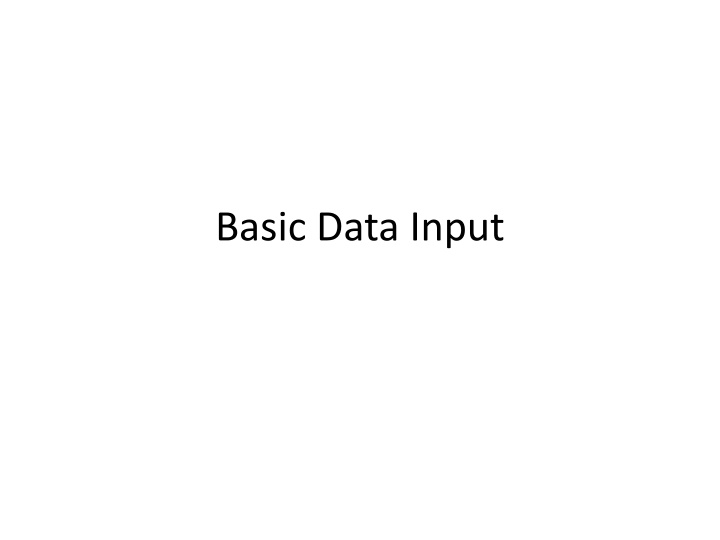
Working with Data Input in R: Tips and Guidelines
Explore essential aspects of data input in R, from handling binary data and reading ASCII data to managing strings, factors, and file paths. Learn about common challenges, interactive code examples, and accessing files efficiently to enhance your R programming skills.
Download Presentation

Please find below an Image/Link to download the presentation.
The content on the website is provided AS IS for your information and personal use only. It may not be sold, licensed, or shared on other websites without obtaining consent from the author. If you encounter any issues during the download, it is possible that the publisher has removed the file from their server.
You are allowed to download the files provided on this website for personal or commercial use, subject to the condition that they are used lawfully. All files are the property of their respective owners.
The content on the website is provided AS IS for your information and personal use only. It may not be sold, licensed, or shared on other websites without obtaining consent from the author.
E N D
Presentation Transcript
To get started, you can give students binary data already in the R format. save() one or more R objects to a file (with .rda extension) Put it on a Web site. Students use load() to read the data into an R session directly load(url( http://eeyore.ucdavis.edu/ESR2010/bayAreaHousing.rda )) Note the use or url() it is an example of a connection , a stream of bytes that come from somewhere , in this case a URL, but could be a file, another program outputting data, a character string.
Reading ASCII data Have to know how to read standard rectangular data tab separated, comma-separated, etc. R has functions for this, i.e. read. table(), read.csv(), etc. read.fwf() for fixed width format. For efficiency reasons, very beneficial to use colClasses parameter to specify target type. But there are lots of issues.
Strings or factors Common gotcha For better or worse, by default, R turns strings in rectangular data read from an ASCII file into factor objects. Use stringsAsFactors = FALSE
Problems in reading Quote characters Missing values Character Encoding Comment characters
Interactive code read.table("~/problemData2", quote = "", comment.char = "", fill = TRUE)
Accessing files - Paths Students need to know about working directories (getwd() & setwd()) This is where the R session is rooted all relative file names are relative to this directory. Students need to recognize that their code will not work if they move files, change directories, etc. i.e. their code is not runnable and so we cannot help fix things. Using URLs makes things universally locatable.
Binary data R can read binary data. But one has to read the bytes and interpret them based on the actual known format of the data, e.g. read 2 integers then followed by n real numbers where n is the value of the second of the first two integers read, Students should not necessarily deal with this, but be aware of the existence of different binary formats & why they are used (compact representation)
Non-standard data input 3 problems: Sample observations from a huge ASCII file w/o reading the whole file Multiple data frames in a single CSV file. ragged data # timestamp=2006-02-11 08:31:58 # usec=250 # minReadings=110 t=1139643118358;id=00:02:2D:21:0F:33;pos=0.0,0.0,0.0;degree=0.0;00:14:bf: b1:97:8a=-38,2437000000,3;00:14:bf:b1:97:90=- 56,2427000000,3;00:0f:a3:39:e1:c0=-53,2462000000,3;00:14:bf:b1:97:8d=- 65,2442000000,3;
